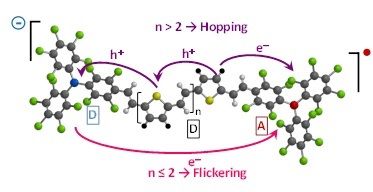
On the Operative Mechanism of Hole Assisted Negative Charge Motion in Ground States of Radical-anion Molecular Wires
C. Franco, P. Mayorga Burrezo, V. Lloveras, R. Caballero, I. Alcón, S. Bromley, M. Mas-Torrent, F. Langa, J.T. López Navarrete, C. Rovira, J. Casado, J. Veciana.
J. Am. Chem. Soc. 2017, 139, 686−692. DOI: 10.1021/jacs.6b12601
Abstract: Operating mechanisms for unimolecular electron transfer/transport in the ground state of radical-anion mixed-valence derivatives occurring between their terminal perchlorotriphenylmethyl/ide groups through thiophene-vinylene oligomers that act as conjugated wires of increasing length up to 53 Å have been determined. The unique finding is that the net transport of the electron in the larger molecular wires is initiated by an electron-hole dissociation intermediated by hole delocalization (conformationally assisted and thermally dependent) forming mobile polaronic states in the bridge that terminate by an electron-hole recombination at the other wire extreme. On the contrary for the shorter radical-anions our results suggest that a flickering resonance mechanism which is intermediate between hopping and superexchange is the operative one. We support these mechanistic interpretations by applying the pertinent biased kinetic models of the charge/spin exchange rates determined by electron paramagnetic resonance and by molecular structural level information obtained from UV-Vis and Raman spectroscopies and by quantum chemical modelling.
Read full article here: http://pubs.acs.org/doi/abs/10.1021/jacs.6b08649






